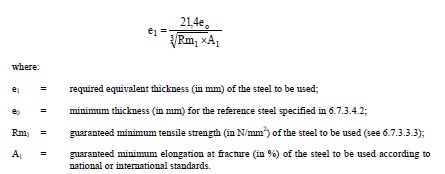thermal insulation, the thermal insulation systems shall satisfy the following requirements:
(a) It shall consist of a shield covering not less than the upper third but not more than the upper
half of the surface of the shell and separated from the shell by an air space about 40 mm across;
(b) It shall consist of a complete cladding of adequate thickness of insulating materials protected
so as to prevent the ingress of moisture and damage under normal conditions of carriage and so
as to provide a thermal conductance of not more than 0.67 (W.m-2.K-1);
(c) When the protective covering is so closed as to be gas-tight, a device shall be provided to
prevent any dangerous pressure from developing in the insulating layer in the event of
inadequate gas tightness of the shell or of its items of equipment; and
1 For calculation purposes g = 9.81 m/s2.
(d) The thermal insulation shall not inhibit access to the fittings and discharge devices.
Portable tanks intended for the carriage of flammable non-refrigerated liquefied gases shall be capable
of being electrically earthed.
Design criteria
Shells shall be of a circular cross-section.
Shells shall be designed and constructed to withstand a test pressure not less than 1.3 times the design
pressure. The shell design shall take into account the minimum MAWP values provided in portable
tank instruction T50 in 4.2.5.2.6 for each non-refrigerated liquefied gas intended for carriage.
Attention is drawn to the minimum shell thickness requirements for these shells specified in 6.7.3.4.
For steels exhibiting a clearly defined yield point or characterized by a guaranteed proof strength
(0.2% proof strength, generally, or 1% proof strength for austenitic steels) the primary membrane
stress σ (sigma) in the shell shall not exceed 0.75 Re or 0.50 Rm, whichever is lower, at the test
pressure, where:
Re = yield strength in N/mm2, or 0.2% proof strength or, for austenitic steels, 1% proof
stress;
Rm = minimum tensile strength in N/mm2.
The values of Re and Rm to be used shall be the specified minimum values according to national or
international material standards. When austenitic steels are used, the specified minimum values for Re
and Rm according to the material standards may be increased by up to 15% when these greater values
are attested in the material inspection certificate. When no material standard exists for the steel in
question, the values of Re and Rm used shall be approved by the competent authority or its authorized
body.
Steels which have a Re/Rm ratio of more than 0.85 are not allowed for the construction of welded
shells. The values of Re and Rm to be used in determining this ratio shall be the values specified in
the material inspection certificate.
Steels used in the construction of shells shall have an elongation at fracture, in %, of not less
than 10 000/Rm with an absolute minimum of 16% for fine grain steels and 20% for other steels.
For the purpose of determining actual values for materials, it shall be noted that for sheet metal, the
axis of the tensile test specimen shall be at right angles (transversely) to the direction of rolling. The
permanent elongation at fracture shall be measured on test specimens of rectangular cross sections in
accordance with ISO 6892:1998 using a 50 mm gauge length.
Minimum shell thickness
The minimum shell thickness shall be the greater thickness based on:
(a) The minimum thickness determined in accordance with the requirements in 6.7.3.4; and
(b) The minimum thickness determined in accordance with the recognized pressure vessel code
including the requirements in 6.7.3.3.
The cylindrical portions, ends (heads) and manhole covers of shells of not more than 1.80 m in
diameter shall be not less than 5 mm thick in the reference steel or of equivalent thickness in the steel
to be used. Shells of more than 1.80 m in diameter shall be not less than 6 mm thick in the reference
steel or of equivalent thickness in the steel to be used.
The cylindrical portions, ends (heads) and manhole covers of all shells shall be not less than 4 mm
thick regardless of the material of construction.
The equivalent thickness of a steel other than the thickness prescribed for the reference steel
in 6.7.3.4.2 shall be determined using the following formula:

